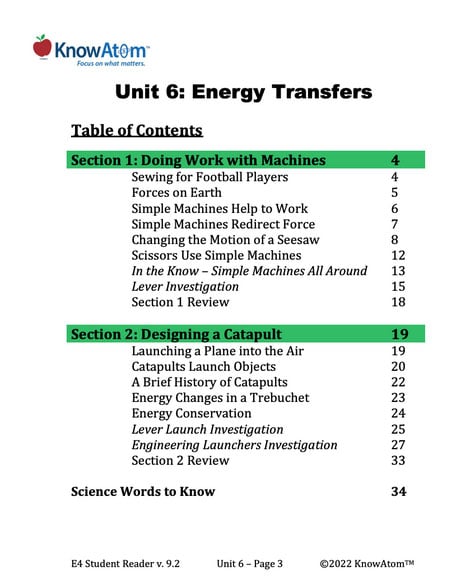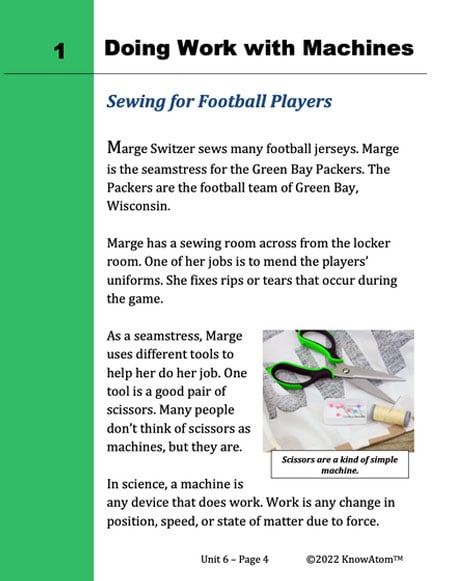In this lesson, students use simple machines to explore the relationship between forces and motion. They focus on how people can use levers to make work easier, investigating how the structure of the lever affects how much work it can do.
In this unit, students use simple machines to explore the relationship between forces, energy, and motion. In the first lesson of the unit, students investigate how levers redirect force to do work. This page showcases key elements of this lesson.
Science background provides teachers with more in-depth information on the phenomena students explore in this unit about energy transfers. Below is an excerpt of this section from the lesson on forces and levers.
Simple machines are all around because they help us do work. Work is any change in position, speed, or state of matter due to force. Remember that a force is a push or pull that acts on an object, changing its speed, direction, or shape, and that force is always necessary to transfer energy into or out of a system.
We can use an inclined plane to explore this relationship between force, energy, and simple machines. An inclined plane is a slanting surface that connects a lower level to a higher level. Inclined planes make it easier to raise or lower a load than just lifting or lowering the load straight up or down. They do this by increasing the distance the load travels.
Objects at the top of the ramp have a form of potential energy, which is stored energy, called gravitational energy. Gravitational potential energy is stored energy related to an object’s height above the ground. To get an object from the ground to the top of the ramp requires kinetic energy, which is the energy of motion. Just lifting the object vertically up requires more force than moving it up the ramp. The ramp requires less force because it increases the distance the object has to travel. It’s important to point out here that the inclined plane doesn’t increase or decrease the amount of energy used because energy cannot be created or destroyed. Instead it redirects the force, extending it over a longer distance. This decreases the amount of force needed to move the object, but you have to move a greater distance. The steeper the inclined plane, the more force will be needed to move the object because it is moving over a shorter distance.
The wheel and axle is another simple machine that makes it easier to do work. An axle is a rod that attaches to the center of a wheel. As the wheel turns, it turns the axle. If the axle is attached to an object like a suitcase or a cart, the wheel and axle can make it easier to move the object.
The wheel and axle reduces the amount of friction that occurs between the ground and the object being pulled. Remember that friction is a force that occurs whenever two objects rub against one another, and it slows motion by transferring the kinetic energy away from moving objects, changing it into heat. One of the ways that wheels reduce friction is by reducing the amount of surface area that comes into contact with the ground.
Imagine trying to push the shopping cart without wheels. The entire bottom of the cart would scrape against the ground. All of the friction would transfer much of the kinetic energy out of the cart, meaning you would have to push the cart with a lot more force to move it the same distance as you would have to push the same cart with wheels.
The shopping cart and the moving truck’s ramp are both made up of different parts, and these parts are often held together with a third kind of simple machine: a screw. A screw is an inclined plane wrapped around a pole that holds things together or lifts materials.
In this lesson, students use simple machines to explore the relationship between forces and motion. They focus on how people can use levers to make work easier, investigating how the structure of the lever affects how much work it can do.

Prepared hands-on materials, full year grade-specific curriculum, and personalized live professional development designed to support mastery of current state science standards.
Effort force: the force you apply to a machine
Lever: a stiff beam that rests on a support called a fulcrum that lifts or moves loads
Simple Machine: any device that helps us do work by redirecting force; there are six kinds: an inclined plane, a lever, a pulley, a screw, a wedge, and a wheel and axle

Sewing for Football Players
Marge Switzer sews many football jerseys. Marge is the seamstress for the Green Bay Packers. The Packers are the football team of Green Bay, Wisconsin.
Marge has a sewing room across from the locker room. One of her jobs is to mend the players’ uniforms. She fixes rips or tears that occur during the game.
As a seamstress, Marge uses different tools to help her do her job. One tool is a good pair of scissors. Many people don’t think of scissors as machines, but they are. In science, a machine is any device that does work. Work is any change in position, speed, or state of matter due to force.
Forces on Earth
Remember that a force is a push or pull that acts on an object. Force is always needed to transfer energy into or out of a system.
Gravity is a kind of pulling force. Gravity is the force of attraction between all matter. On Earth, the force of gravity pulls all objects near Earth’s surface down.
Gravity is why a football thrown by a player will fall back to the ground. It is also why we don’t all float off into space.
Friction is another force that slows motion whenever two objects rub against each other. Friction slows motion because it causes some of the energy of the moving object to change into heat.


Forces on Earth
Remember that a force is a push or pull that acts on an object. Force is always needed to transfer energy into or out of a system.
Gravity is a kind of pulling force. Gravity is the force of attraction between all matter. On Earth, the force of gravity pulls all objects near Earth’s surface down. Gravity is why a football thrown by a player will fall back to the ground. It is also why we don’t all float off into space.
Friction is another force that slows motion whenever two objects rub against each other. Friction slows motion because it causes some of the energy of the moving object to change into heat.
Simple Machines Help Do Work
To understand how scissors use force to do work, we need to begin with their structure. Scissors are made up of two smaller simple machines. A simple machine is any device that helps us do work by redirecting force.
We’ll use a seesaw to explore this idea further because seesaws are similar to scissors. Both seesaws and scissors use levers to do work. A lever is a simple machine that is made up of a stiff beam that rests on a support called a fulcrum. The beam is called an arm.
Scissors are made up of two levers. Seesaws are one lever. They have a simple structure. A long, narrow board is supported by the fulcrum in the middle of the board.
For the hands-on activity in this lesson, students carry out several investigations to analyze the phenomena of how a lever’s fulcrum and the effort force affect the amount of force needed to move a load. Students analyze their protopye’s data to solve a problem using simple machines to redirect force and make work easier.
KnowAtom incorporates formative and summative assessments designed to make students thinking visible for deeper student-centered learning.

Standards citation: NGSS Lead States. 2013. Next Generation Science Standards: For States, By States. Washington, DC: The National Academies Press. Neither WestEd nor the lead states and partners that developed the Next Generation Science Standards were involved in the production of this product, and do not endorse it.
